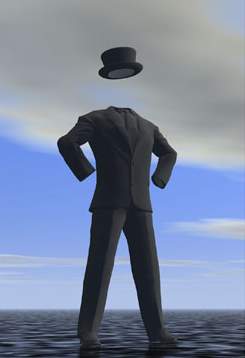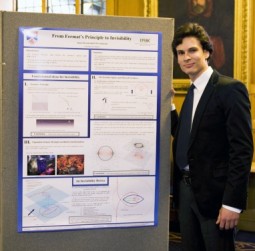 This podcast provides extended version of our interview with Janos Perczel about his new Invisibility Cloak.
This podcast provides extended version of our interview with Janos Perczel about his new Invisibility Cloak.
Background:
An undergraduate at the University of St. Andrews in Scotland has overcome a major hurdle in the development of invisibility cloaks by envisioning an optical device that would allow the cloak to hide things against CHANGING backgrounds. The Institute of Physics and German Physical Society’s New Journal of Physics, published the study today, and the lead author, Janos Perczel, spoke with us about it from Hungary, via Skype,. But first — putting aside Harry Potter’s cloak of invisibility for a moment, in real life, scientists have cloaked some palm-sized objects . . . but not especially well. Here’s Janos Perczel.
Perczel
It depends on what you mean by an invisibility cloak. The sort of stuff you see in Harry Potter films has never been made yet. There have been experiments to test the theory but these experiments have always featured invisibility in some reduced form.
So far, cloaking only works when an object’s against one single field of steady background wavelength, like a “blue screen.” And even that’s complicated. “Cloaking” conceals an object by bending light around it. Perczel says it’s similar to putting a rock in a river, where the water bends around and covers the rock and makes it “disappear.. But just as water must speed up in order to hurry around the rock, bending light has required accelerating the light. And super-speeded light flows too fast to allow a cloaking devices to adjust to changing backgrounds. In the new report, Perczel and colleagues offer a solution. They call it an invisibility sphere, and it buys enough time for the cloak to adjust to changing backgrounds by, well — what else? Their device slows down the normal speed of light.

Perczel
So that all the light speeds that we use in our cloak will be less than the speed of light, in vacuum, so that the cloak we propose here would work for any frequency and would also work against an ever-changing background and a multiplicity of colors and, well anything.
It may be decades before this technology moves from theory to real world applications. But Perczel predicts that there will be plenty.
Perczel
I’m not sure I would want to talk about the potential military applications, because that’s not something I’m terribly keen on. But, apart from those, this whole invisibility subject is based on transformation optics. That’s the key word here, and it tells us how to control light and how to guide it pretty much any way we want to guide it around. This might lead to the birth of incredible optical devices.
Perczel envisions images that are sharper than the quality of the light the first hit the lens. And who knows? Maybe someday invisibilites cloaks will lead to anti-wrinkle creams and perhaps lower production costs of future Harry Potter movies. Thanks to Shelley Schlender for doing this report. You can hear an extended version of the interview, on our website, howonearthradio.org.
Podcast: Play in new window | Download (Duration: 17:08 — 15.7MB)
Subscribe: RSS



